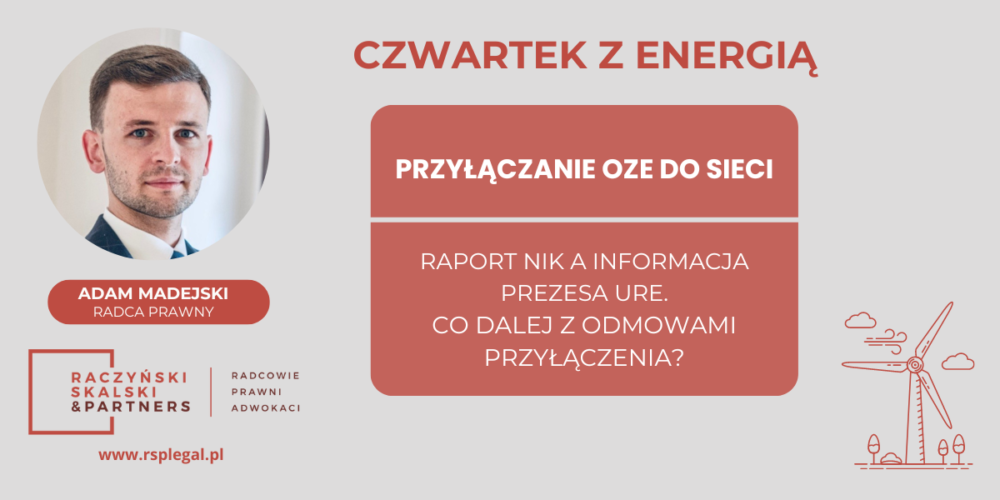March this year is full of events driving the discussion of RES installations, particularly in the context of the issue of refusal to connect installations to the electricity grid for technical and economic reasons. Two documents provide the most room for discussion:
1. the Supreme Audit Office report “Information on the results of the audit. Development of the electric power distribution network”
2. information of the President of the Energy Regulatory Office No. 15/2024 on the issues that cause the most common doubts in the area of grid connection
Both documents were published in the first quarter of the year, but by that time the order to carry out non-market capacity reduction of RES installations (so-called redispatch) had already been announced several times.
Will the conclusions of both documents help point the way forward for the power system to improve energy security?
1. Conclusions of the NIK report – distribution networks are underinvested
The main thesis put forward by the NIK auditors boils down to the sentence: “The measures taken by state authorities and power companies have not significantly contributed to the development of the distribution network.” Although increased investment and modernization expenditures have been recognized, among other things, it has been pointed out that still the networks are not adapted to the growing popularity of RES. The NIK stresses that network development plans have not been implemented, in some cases even to a gap of 48%.
It will come as no surprise to find that the electricity system was not designed for a distributed formula. Still, a significant part of the high-voltage and medium-voltage networks is several decades old, and their condition negatively affects the quality parameters of transmitted electricity. The process of reorganizing the most important transmission corridors to optimize the energy injected into the grid is only just underway. These circumstances create very difficult conditions for the construction of renewable energy installations – according to the NIK, in the first half of 2022, the rate of refusal to issue connection conditions was 99.3%, and in terms of energy storage – 30%.
Allegations are made not only against distribution system operators, but also against the ERO President. According to the auditors, appeal proceedings before the ERO are too complex and formalized, and thus inefficient and protracted. The correctness of the ERO President’s supervision of whether distribution system operators comply with the established development plans was questioned.
2. Information of the ERO President – electricity system operators cannot take shortcuts when refusing to issue connection conditions
In Information No. 15/2024, the ERO President points out the most important issues related to the interpretation of a refusal to connect for technical and economic reasons. The court rulings cited in the information, as well as the position taken by the ERO President himself, indicate unequivocally that a connection should be denied only if the technical obstacles are objective and permanent and cannot be removed by economic outlays.
The ERO President further pointed out that it is not within the competence of electricity system operators to examine whether an installation can be located on a given property if the relevant public administration authorities have issued valid decisions in this regard. Such a statement is in line with the correct interpretation of the law, however, there have been cases where operators have refused to issue connection conditions questioning the content of, for example, decisions on development conditions.
It is worth noting that the ERO President pointed out the need for broader application of the so-called commercial connection, i.e. one in which part or all of the outlays necessary to allow the installation to be connected to the grid are covered by the investor.
Finally, important information was provided in the context of rules for cable pooling, i.e. connecting two or more RES installations to a single connection. While the regulations in this regard, introduced into the Energy Law in September last year, are quite clear, in practice – in the opinion of the ERO President – it was necessary to clarify, among other things, the distribution of obligations between generators and operators, as well as the principles of applying individual technical regulations to successive installations being connected.
3. Grid connection refusals in practice – jurisprudence
As the ERO President himself pointed out in his information, the premises for refusing to issue connection conditions technical and economic are not defined in the law, and the way they are interpreted is primarily at the discretion of the operators. Given the fact that there are several “major” distribution system operators in Poland, the process of evaluating the occurrence of grounds for refusal may not guarantee an objective and transparent process for evaluating an application for connection conditions.
The case law to date confirms that it is the distribution system operators who are on the “front line” of assessing the fulfillment of the prerequisites for the issuance of connection conditions (e.g., SOKiK judgment of March 29, 2021, XVII AmE 300/19; SOKiK judgment of September 19, 2019, XVII AmE 307/17). The President of the ERO, who is a party to these proceedings, did not dispute such a thesis; it would, after all, be inconsistent with the wording of Article 7(1) of the Energy Law.
However, the most discussion arises on the grounds of who should bear the costs of network development and to what extent. A fairly rich body of jurisprudence has developed in this area, on the basis of which a certain gradation and distribution of financial obligations can be constructed:
1. electricity system operators have a general obligation to maintain, modernize and develop the network as a whole system – this is not disputed, and the obligation follows directly from the provisions of the Energy Law (SOKiK judgment of November 18, 2020, XVII AmE 432/18). At the same time, the same judgment concludes that the obligation of operators is not of a “total” nature, that is, to provide connection to every applicant.
2. The obligation to expand the network is of a general and public law nature, and, as a rule, customers are charged only for the cost of the connection fee, i.e. the outlay that the energy company will incur in order to make the customer’s individual connection to the network (SOKiK judgment of May 18, 2016, XVII AmE 186/15).
3. The system operator may not transfer to the customer, as part of the connection fee, the costs incurred for the expansion and modernization of the network (Court of Appeals in Warsaw, judgment of June 28, 2013, VI ACa 1682/12). Such an action is contrary to the public law nature of the obligation incumbent on the operator.
4. If the technical conditions for the issuance of connection conditions do not exist, and the economic outlay will be disproportionate to the general obligation incumbent on the operator (i.e., the economic conditions will also be lacking), then the parties may carry out the connection under the commercial conditions referred to in Article 7, paragraph 9 of the Energy Law (Warsaw Court of Appeals ruling of June 9, 2016, VI ACa 92/15).
4. Possible developments
It is already known that under the so-called Transmission Spec Act, some of the high-voltage lines operating in the distribution networks have been included in the accelerated mode of implementation. This is certainly good news in terms of increasing system capacity. Year after year, operators’ expenditures on investments and repairs are also increasing – now the total amounts are in the billions. Unfortunately, the pace of work often cannot be accelerated, especially where there is a comprehensive replacement of old sections with completely new constructions.
Certainly, the pain of numerous refusals to issue connection conditions will continue until there are legislative, transparent rules for when such a refusal can be issued. The ERO President himself makes a diagnosis in this regard in the information issued, pointing out that technical and economic conditions are concepts surrendered to the actual interpretation of electricity system operators. While it is clear that each case will require individual evaluation, it is impossible to consider such a solution effective – many investors remain discouraged from implementing RES projects if they have to fight for the issuance of connection conditions in an administrative procedure or spend significant amounts to upgrade the grid on commercial terms.
There is no doubt that much good can come from the popularization of cable pooling, but in order to make optimal use of its possibilities it is necessary to combine wind and photovoltaic projects. As long as regulations on the siting of onshore wind farms are not liberalized, the pooling of RES capacity within a single connection will be used only in part.



